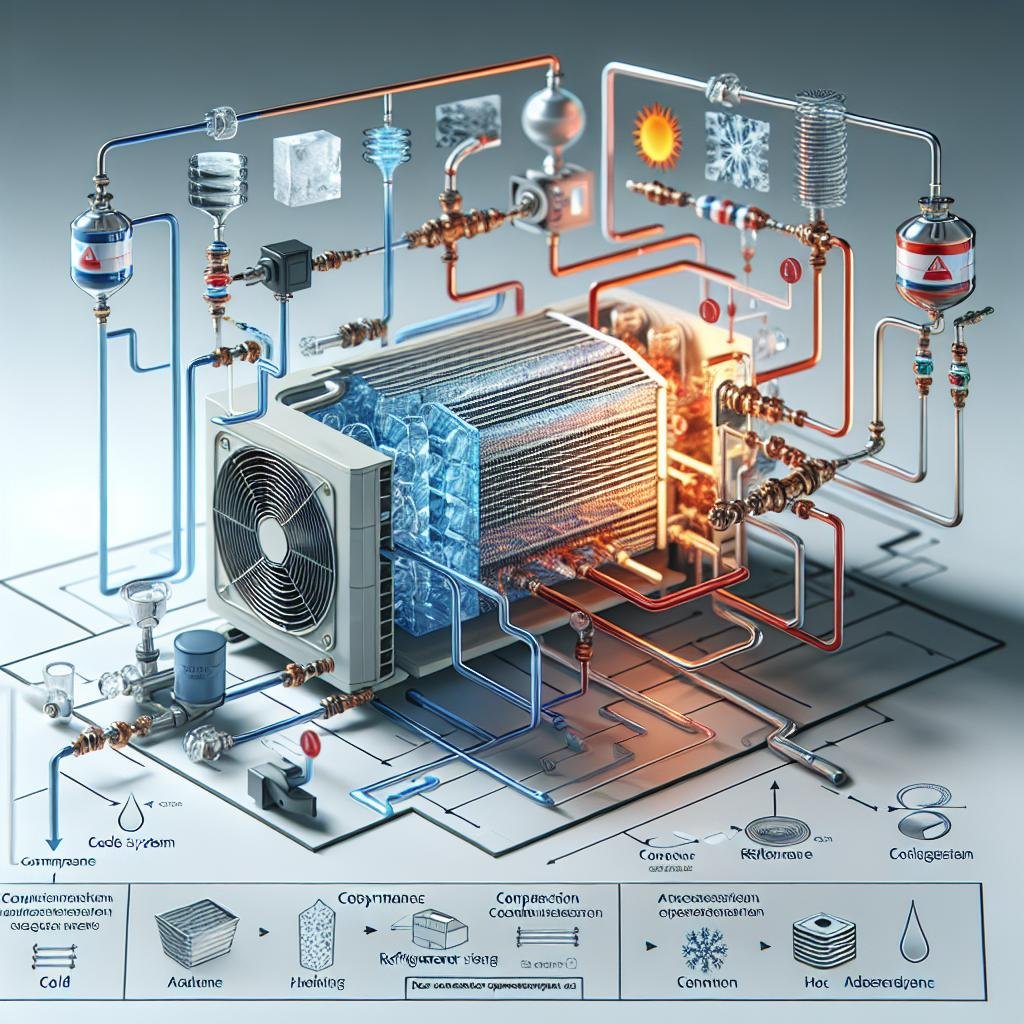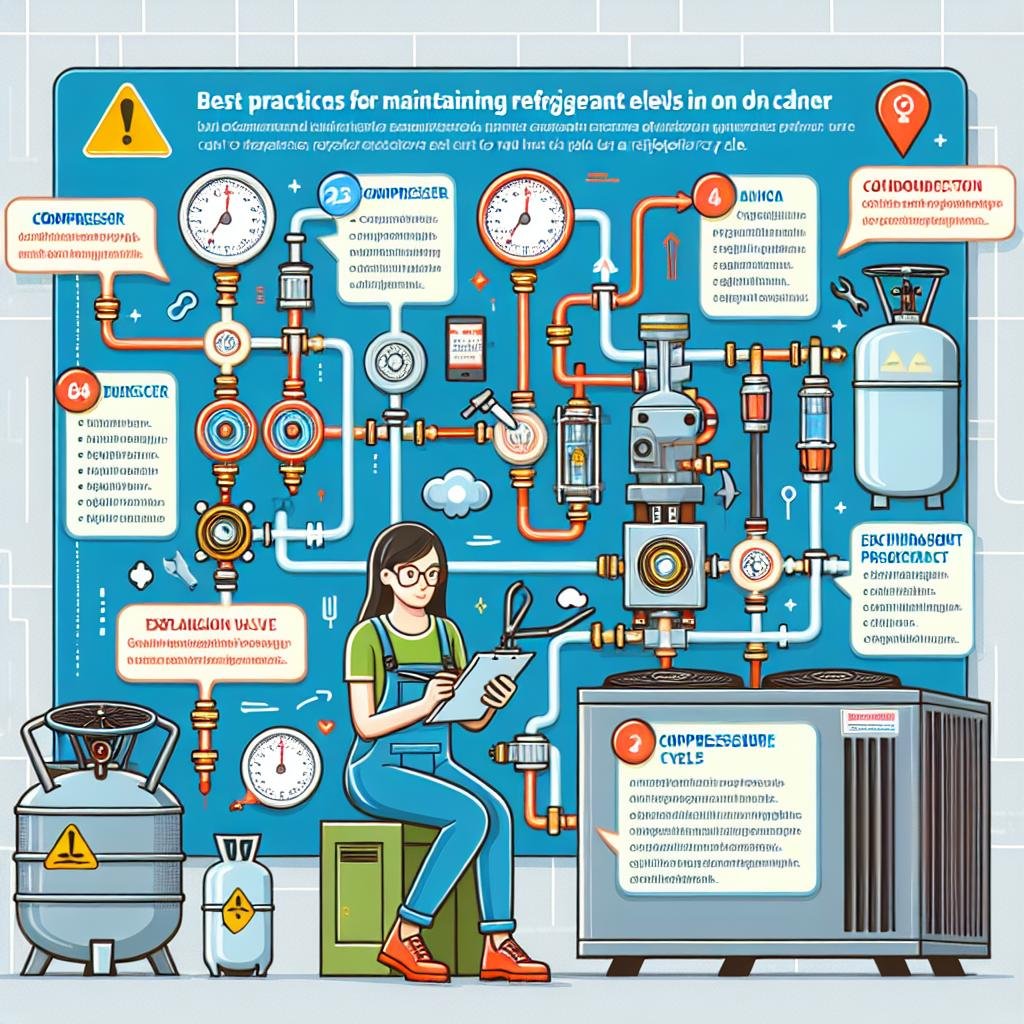Understanding the Role of Refrigerant in Achieving Efficient Cooling with a Mini Split AC System
Imagine stepping into a cool oasis on a sweltering summer day, where the sun’s relentless heat is held at bay, and comfort reigns supreme. Behind this refreshing sanctuary lies one unsung hero: the refrigerant. This remarkable substance plays a pivotal role in the world of mini split air conditioning systems, transforming warm air into a refreshing breeze that envelops you in tranquility. But what exactly is refrigerant, and how does it work its magic to keep our spaces cool and cozy? In this friendly exploration, we’ll dive into the fascinating science of refrigerants, uncovering their vital contributions to the efficiency of mini split AC systems. Whether you’re a seasoned homeowner or just starting your journey into climate control, we will break down complex concepts into digestible bits, making it easy to appreciate the intricate dance of temperature regulation that’s happening right in your living room. So, grab a cold drink, settle in, and let’s embark on this enlightening journey together!
Exploring the Basics of Refrigerants and Their Importance in Cooling Systems
Refrigerants are the unsung heroes of modern cooling technology, playing a critical role in the efficiency and effectiveness of systems such as mini split air conditioners. These chemicals undergo phase changes, absorbing heat from the indoor environment and releasing it outside, thus creating a comfortable living space. Understanding the properties and types of refrigerants can illuminate their importance in achieving optimal performance in cooling systems. A few key characteristics include:
- Thermal Efficiency: Different refrigerants have varying capacity to absorb and transfer heat.
- Environmental Impact: Some refrigerants have a lower Global Warming Potential (GWP) and ozone-depleting properties, making them a more eco-friendly choice.
- Operational Temperature Range: Selecting the right refrigerant ensures efficient operation under different climatic conditions.
When it comes to mini split systems, the choice of refrigerant directly affects the unit’s performance and energy consumption. The most commonly used refrigerant types include R-410A and R-32, which boast excellent thermodynamic properties. Each type has its own benefits, and the following table summarizes some of these characteristics:
| Refrigerant Type | GWP | Energy Efficiency | Ozone Depletion Potential |
|---|---|---|---|
| R-410A | 2088 | High | 0 |
| R-32 | 675 | Very High | 0 |
Selecting the right refrigerant is vital not only for effective cooling but also for reducing energy costs and minimizing environmental impact. With the right choice, mini split AC systems can provide both comfort and sustainability, making refrigerants a key element in the overall design and operation of cooling technologies.
The Science Behind Refrigerant Cycles and How They Enhance Efficiency
The journey of refrigerants within a mini split AC system is a fascinating interplay of physics and thermodynamics. At the heart of the cooling process, refrigerants are substances that absorb and release heat efficiently. When the refrigerant enters the evaporator coil, it is in a low-pressure, cool liquid state. As warm indoor air passes over the coil, the refrigerant absorbs heat, causing it to evaporate and transform into a gas. This cycle of heat absorption is vital because it creates the cool air that will be circulated throughout your living space. The finesse of this exchange allows for maximum cooling capacity without heavy energy consumption, making refrigerants key players in energy efficiency.
Equally important is the role of the compressor, which pressurizes the refrigerant gas, raising its temperature before sending it to the condenser coils outside. Here, the gas releases its stored heat into the outdoor environment and condenses back into a liquid state. The continuous cycle not only enhances the system’s efficiency but also maximizes its effectiveness without requiring excessive energy inputs. To further enhance understanding, consider the following aspects that contribute to the robustness and efficiency of refrigerant cycles:
- Phase Change: The transition between gas and liquid states optimizes heat absorption and release.
- Pressure Management: Maintaining optimal pressure levels is crucial for efficient cooling.
- Low GWP Options: Using refrigerants with low global warming potential helps reduce environmental impact.
| Refrigerant Type | Phase Change Temperature (°C) | Global Warming Potential |
|---|---|---|
| R-410A | -51.6 | 2088 |
| R-32 | -49.2 | 675 |
| R-290 (Propane) | -42.1 | 3 |
This structured workflow in refrigerant cycles ensures that mini split AC systems operate at optimal performance levels while maintaining energy efficiency. Understanding this science empowers users to make informed choices about their cooling systems and helps contribute to a more sustainable future.

Choosing the Right Refrigerant for Your Mini Split AC: Key Considerations
Choosing the right refrigerant is pivotal to ensure optimal performance and efficiency of your mini split AC system. When evaluating options, it’s essential to consider environmental impact, efficiency rating, and compatibility with your existing system. Different refrigerants have varying Global Warming Potential (GWP) levels, so selecting one with lower GWP will minimize your carbon footprint while ensuring effective cooling. Additionally, the efficiency rating, often expressed as Seasonal Energy Efficiency Ratio (SEER), can significantly affect your energy bills and overall comfort. You’ll also want to ensure that the refrigerant works harmoniously with your mini split’s components to avoid costly repairs down the line.
When assessing refrigerants, you may come across common options like R-410A and R-32. Here’s a quick comparison of key factors that may help in making your decision:
| Refrigerant | GWP | Efficiency | Compatibility |
|---|---|---|---|
| R-410A | 2088 | Good | Widely compatible |
| R-32 | 675 | Better | Newer systems |
By keeping these factors in mind, you can make an informed choice that not only meets your cooling needs but also aligns with your commitment to the environment and energy efficiency. Remember, the right refrigerant choice can lead to a healthier system and a more comfortable home, enhancing your mini split AC experience.
Best Practices for Maintaining Refrigerant Levels to Optimize Performance
To ensure your mini split AC system operates at peak efficiency, it’s essential to regularly check and maintain refrigerant levels. One of the simplest yet most effective practices is to schedule annual professional inspections. During these visits, a qualified technician can detect any leaks, assess the overall health of the refrigerant system, and recharge the refrigerant if necessary. Caught early, small issues can prevent larger, costlier repairs down the line. Additionally, keeping the area around your outdoor unit clear and free of debris helps mitigate the risk of overheating and maintains optimal airflow, which is critical for efficient cooling.
Moreover, homeowners should familiarize themselves with the signs of low refrigerant levels, which may include inadequate cooling, hissing or bubbling sounds, or ice buildup on the evaporator coils. If you notice any of these symptoms, do not hesitate to contact a professional. Regular filter changes are another vital aspect of maintaining balance within your system; dirty filters can lead to a strain on refrigerant levels and overall performance. Consider implementing these practical tips:
- Conduct monthly visual checks around your mini split unit to ensure no obstructions are present.
- Change or clean filters every 1-3 months to promote better air circulation.
- Monitor energy bills for unexpected spikes, which can indicate inefficient operation due to low refrigerant.
| Refrigerant Maintenance Tips | Frequency |
|---|---|
| Annual Professional Inspection | Once a year |
| Filter Cleaning/Replacement | Every 1-3 months |
| Visual Checks | Monthly |
| Monitoring Energy Bills | Monthly |
Q&A
Q&A: Understanding the Role of Refrigerant in Achieving Efficient Cooling with a Mini Split AC System
Q1: What is a mini split AC system, and how does it work?
A1: Think of a mini split AC system as the cool, quiet cousin of traditional air conditioning units. It consists of two main components: an indoor unit that blows refreshing air into your space and an outdoor unit that does the heavy lifting of heat rejection. The magic happens thanks to refrigerant—this special fluid circulates between the two units, absorbing heat from inside your home and releasing it outside to keep things pleasantly chilly indoors.
Q2: So, what exactly is refrigerant, and why is it important?
A2: Refrigerant is like the superhero of your AC system! This specialized fluid has a unique ability to change states—from liquid to gas and back again—allowing it to absorb heat effectively. In a mini split AC, refrigerant plays a vital role in transferring heat, which directly influences how efficiently your system operates. Without the right refrigerant, your mini split would be just a fancy fan rather than an effective cooling powerhouse.
Q3: How does the type of refrigerant affect cooling efficiency?
A3: Great question! Not all refrigerants are created equal. The type of refrigerant used in your mini split can impact its energy efficiency, cooling capacity, and environmental footprint. For instance, modern systems often use R-410A, which is more efficient and ozone-friendly than older refrigerants like R-22. Choosing a mini split that uses the latest refrigerant technology ensures that you enjoy optimal cooling without leaving a negative mark on our planet!
Q4: How does refrigerant leak affect my mini split’s performance?
A4: Think of refrigerant leaks like a flat tire for your mini split: without sufficient refrigerant, your system struggles to cool your space effectively. A leak can lead to diminished cooling capacity, increased energy bills, and longer run times, putting unnecessary stress on the unit. If you suspect a leak, it’s best to call in a professional to assess and repair the issue pronto!
Q5: What maintenance does the refrigerant require to ensure efficient cooling?
A5: Keeping your mini split’s refrigerant happy mostly involves regular check-ups! Annual maintenance by a qualified technician can help ensure there are no leaks, the refrigerant levels are adequate, and the coils are clean. Just like you wouldn’t ignore a check engine light, don’t skip on your AC maintenance—it’s the key to smooth, efficient, and reliable cooling all season long!
Q6: Are there any eco-friendly refrigerants available?
A6: Absolutely! The move toward more environmentally friendly refrigerants has gained traction in recent years. Many manufacturers are now using refrigerants with lower global warming potential (GWP), such as R-32. This not only helps your cooling system be more energy-efficient but also contributes to a greener footprint. When shopping for a mini split, look for options that prioritize eco-friendliness without compromising performance.
Q7: Is it more efficient to run my mini split constantly, or should I turn it off when I leave?
A7: This is a classic dilemma! Generally, it’s more efficient to set your mini split to “auto” or a consistent temperature rather than turning it off entirely every time you step out. Mini split systems are designed to maintain a comfortable environment efficiently, so doing constant on-and-off cycles can use more energy than simply letting it run. Plus, when you come back home, you’ll walk into a cool sanctuary rather than waiting for it to cool down!
Q8: How can I maximize the efficiency of my mini split AC system?
A8: You’re already on the right path by understanding refrigerants! Here are a few more tips: Keep the outdoor unit clear of debris, ensure your indoor filters are clean, optimize the thermostat settings, and schedule that annual maintenance. Remember, a well-kept mini split is a happy mini split, and more happiness means better efficiency and comfort for you!
So get ready to enjoy cool breezes and efficiency updates your mini split deserves! Happy cooling!
In Conclusion
As we wrap up our journey through the fascinating world of refrigerants and their vital role in mini split AC systems, it’s clear that the magic of cooling isn’t just about the temperature on your thermostat. It’s about understanding the intricate dance between science and technology that allows us to create comfortable, refreshing spaces in our homes.
Whether you’re looking to beat the summer heat or simply trying to create a cozy environment year-round, appreciating the role of refrigerant helps us make informed choices when it comes to our cooling systems. So, the next time you feel that glorious chill in the air from your mini split, remember to tip your hat to the unsung hero—the refrigerant!
Stay cool, stay informed, and enjoy the comfort of your space knowing that you’re equipped with the knowledge to make the best decisions for your home. After all, a little understanding goes a long way in optimizing efficiency and ensuring a cool, pleasant haven for you and your loved ones!

